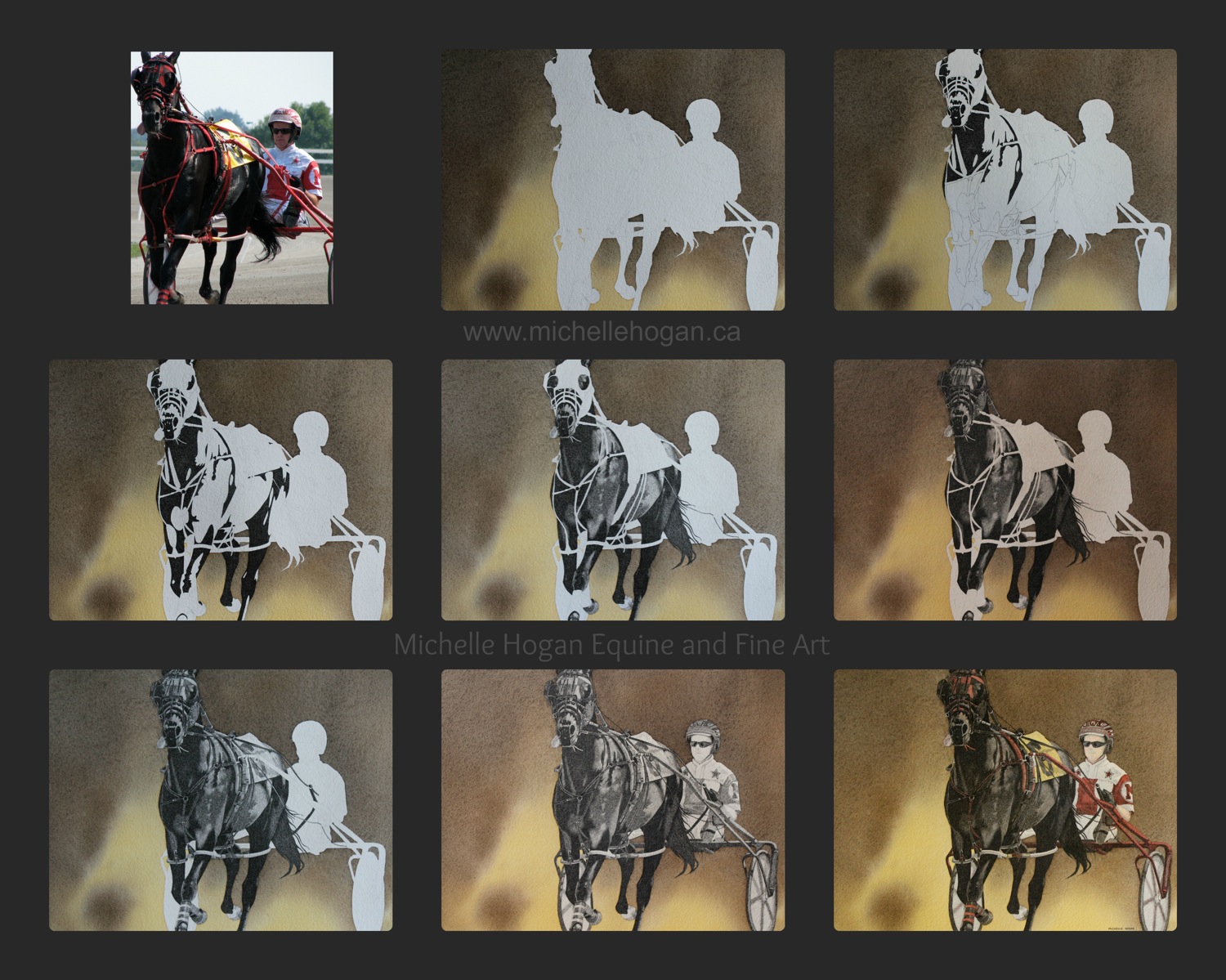Fan Feature – Michelle Hogan
Meet Michelle Hogan, a self-proclaimed “horse crazy artist,” who uses a unique art form to showcase the experiences and feelings that can only come from living with, working with and loving horses. Visit her website at http://www.michellehogan.ca/Welcome.html and check her out on Facebook.
How did you become interested in horses and harness racing, both as an artist and personally?
Honestly, I can’t remember a time when I was not interested in horses. I grew up just down the road from Flamboro Downs in Ontario, and you can’t drive anywhere without passing a training center in that area. I suppose part of the “blame” could be placed on a college friend of my mother’s. She had horses and we would visit a few times each year. She was the first one to set a brush in my hand and make me work for what I wanted (to ride).
Harness racing came later. My first backstretch visit was arranged by a track employee, who happened to be a friend’s father. It wasn’t long before I was posting a notice looking for a job. I started out as a groom when I was 14 years old. I worked for a few small stables on the backstretch and later worked on a breeding farm. Over the years I’ve done a bit of everything. I had my trainer’s license and also worked as a vet assistant.
As an artist, there was never a question of what I would paint/draw. My art is a reflection of my passion for horses and harness racing.
How is the way your paintings are done different than most, and why do you enjoy using this technique with horses?
Everyone is familiar with the more common painting mediums (oils, acrylics, watercolor, pastel, etc.), but not many have heard of the method I use, and it kind of surprises people at first. I work in pen and ink using a technique called “stipple” or “pointillism.” What this means is that my drawings are made up of tiny dots of ink. I use some of the smallest pens available to artists, and this allows me to put a great amount of detail into my drawings. I prefer to leave these drawings as black & white, but I will also color them using watercolor paint. With horses, this technique allows for high realism and a smooth appearance. The only downside is that this technique is very time consuming, and paintings that other artists may complete in days or weeks will often take me weeks or months, depending on their size.
You’re drawn to horses both as an artist and in your life. What is it about horses that draw you in in each way? Is it the same things or different?
Being drawn to horses seemed to be instinctual. It must have been in my blood. My parents, however, say they have no idea where the art gene or horse gene came from! As far back as I remember, it was there.
What is it about Standardbreds that you prefer them over other breeds? What are you trying to capture when painting Standardbreds specifically?
Versatility and temperament first and foremost. I have worked with Standardbreds, Thoroughbreds, Warmbloods, Quarter Horses, Arabians and everything in between. No breed is as versatile as the Standardbred, and no breed is as level headed. It’s not just the horses either. There is a great sense of community and family amongst Standardbred horsemen and women.
When drawing/painting Standardbreds I try to capture a feeling. For me, each piece reflects a moment and emotion left over from my time spent at the track.
Do you have a favorite subject or picture? What is it about that?
My favorite subject, of course, is harness racing, simply because it played such a big role in my life. I love to draw trotters! The pattern of their gait and the way they carry themselves is really eye catching. Less harness to draw is just a bonus. I like to bring attention to the eyes, so I will often include equipment, such as hoods, to draw attention to them. Deep shadows are also a must; I love how they play across a horse’s coat and pull a viewer’s eye into the painting.
What inspires you?
What DOESN’T inspire me! I am inspired by the little moments: The flare of nostrils, the ripple of muscles, light playing across a horse’s coat. I am inspired by the memories: Rubbing legs for hours on end, holding a winner’s head for the photo, the track lights and the hoof beats. Every hour of every day spent with horses is an inspiration to me.
What do you want people to see in your pictures, or understand about horses/harness racing from them?
This is a question near to my heart. With the struggling industry recently in Ontario, I am focused on doing what little I can to bring new fans to the sport of harness racing. When someone walks into my studio and looks at one of my racing pieces, I want them to ask questions. I want to start a conversation about that piece and about harness racing. I want these viewers to see an exciting and entertaining sport and I want them to leave the studio with a desire to see it live. For them, I try to capture the excitement and leave them wanting more. I display my work alongside real equipment that they can touch, feel, and understand.
As for people who are already involved in harness racing, I want them to look at my work and be able to feel what they feel in similar moments at the track. I want them to see the quiet moments with their horses, feel the adrenaline pumping, or simply smile at something familiar and meaningful.

